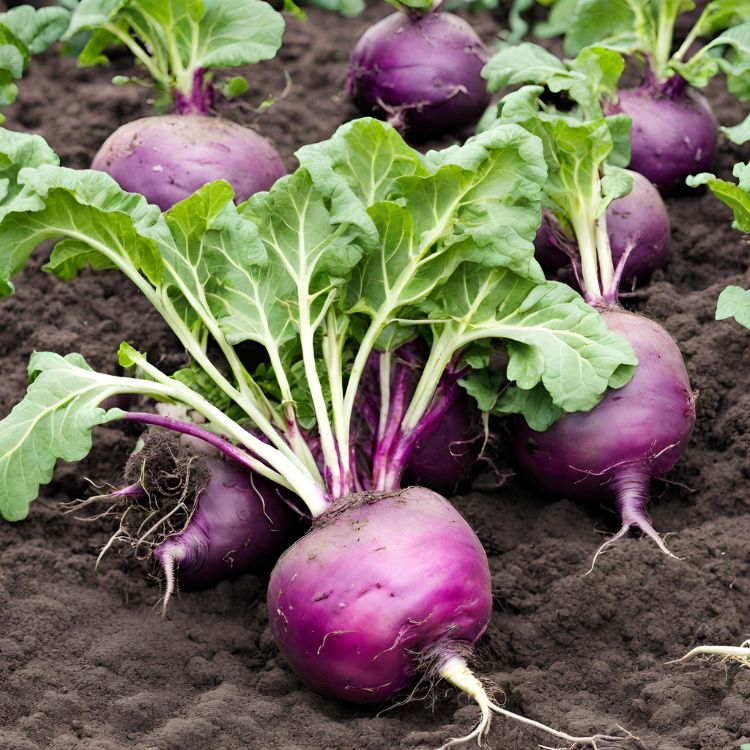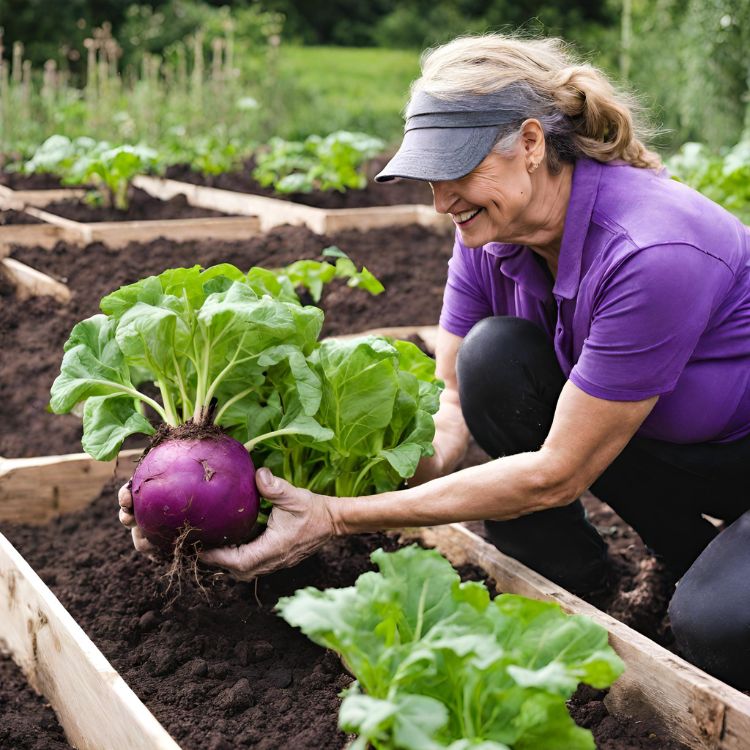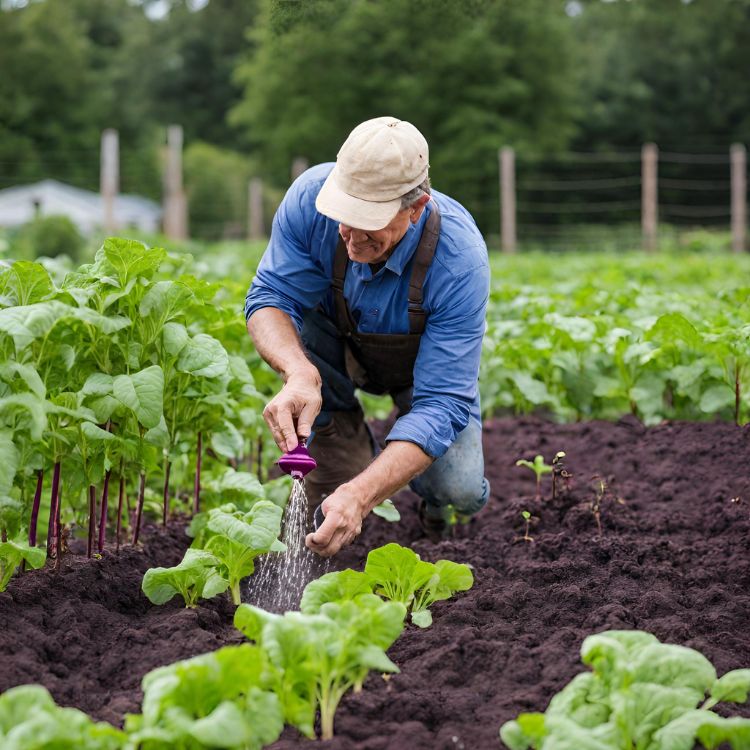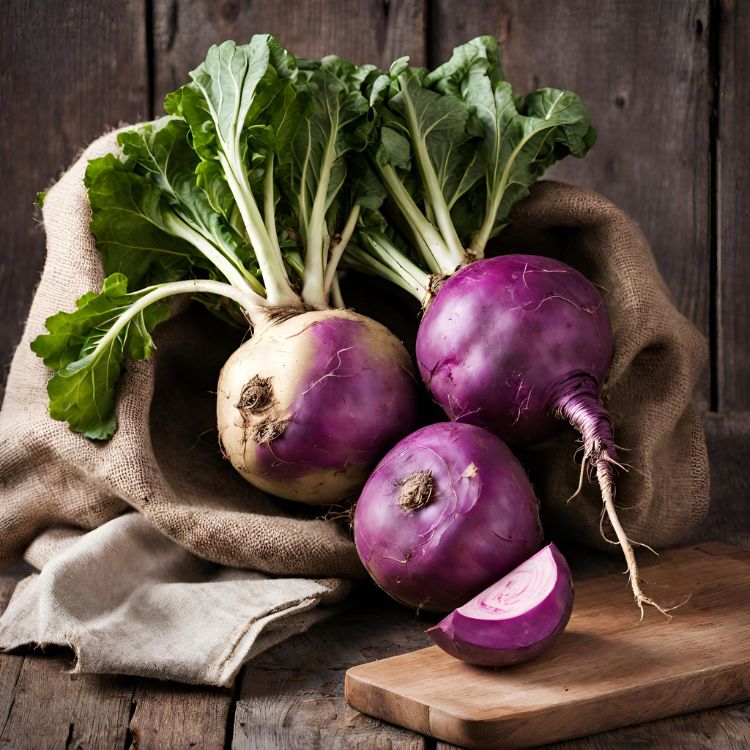
Key Takeaways
- Cultivating purple top rutabagas is a rewarding experience that offers the satisfaction of growing your own produce.
- Rutabagas are resilient and hardy plants, ideal for beginner gardeners and seasoned horticulturists alike.
- By growing your own rutabagas, you contribute to sustainable practices and reduce reliance on store-bought produce.
- Purple top rutabagas are rich in essential nutrients like fiber, vitamin C, potassium, and magnesium, enhancing your diet.
- The resurgence of root vegetables like rutabagas in contemporary cooking allows for culinary creativity.
- Participating in growing your own rutabagas can foster community connections—from sharing harvests with neighbors to participating in local garden clubs or farmers’ markets.
- Investing time in growing rutabagas contributes to food security and self-sufficiency, crucial elements in today’s world.
Whether you’re a seasoned gardener or just starting, cultivating your own purple top rutabagas can be a rewarding experience. Not only does it offer fresh produce right at your doorstep, but it also contributes to a more sustainable and health-conscious lifestyle.
Unearthing the roots of our garden vegetables can truly be a captivating journey that takes us on a historical and culinary adventure. Among the many treasures waiting to be discovered, the purple top rutabaga stands out as a resilient and nutritious root vegetable with a rich history and a vital place in sustainable cuisine practices today. This humble vegetable, once overlooked, has now become a staple in modern cooking, celebrated for its versatility and health benefits.
The purple top rutabaga’s story is one of resilience and adaptability, tracing back to its origins as a hardy crop that sustained many during times of scarcity. As we explore the growth trends of this American favorite, we uncover its nutritional value, packed with essential vitamins and minerals that promote overall well-being. In contemporary cooking, the rutabaga has experienced a revival, finding its way into innovative dishes that showcase its unique flavor and texture. Its resurgence symbolizes a return to our culinary roots, honoring traditional ingredients while embracing new ways of preparing and enjoying them.
Unraveling the History of the Purple Top Rutabaga
Embark on a journey through time as we uncover the fascinating story behind the Purple Top Rutabaga, a humble yet iconic vegetable that has left an indelible mark on culinary history.
Intriguing Beginnings: Step back in time and explore the origins of the Purple Top Rutabaga, a tale of botanical fusion and culinary legacy that spans centuries.
Botanical Fusion: Discover the intriguing origins of the Purple Top Rutabaga, known as “Swede,” as we delve into its unique lineage, tracing back to medieval Europe.
Transatlantic Debut: Follow the journey of the Purple Top Rutabaga across the Atlantic Ocean, from its European roots to its triumphant arrival in North America during the 19th century.
Kitchen Staple: Witness the rise of the Purple Top Rutabaga as it becomes a cherished staple in American kitchens, celebrated for its regal appearance and versatile culinary uses.
Culinary Versatility: Explore the culinary versatility of the Purple Top Rutabaga as we showcase its ability to elevate a wide range of dishes, from comforting soups to indulgent roasts.
Culinary Endearment: Experience the enduring love affair between Americans and the Purple Top Rutabaga, a vegetable that has carved out a permanent place in the heart of American cuisine.
The Purple Top Rutabaga: A Hardy American Favorite

The Purple Top Rutabaga is a beloved vegetable in American cuisine for its hardy nature and rich flavor profile. Thriving in colder climates where other vegetables may struggle, the rutabaga’s resilience has made it a staple in traditional dishes and innovative creations alike. Its versatility in dishes such as stews and salads has allowed it to provide comfort and nutrition for generations of Americans.
One of the key characteristics that sets the Purple Top Rutabaga apart is its ability to withstand harsh conditions, making it a reliable source of sustenance throughout the years. Its robust nature allows it to be stored for extended periods, ensuring a consistent supply of this flavorful vegetable. Whether it is roasted to bring out its natural sweetness or added to soups for a hearty texture, the rutabaga’s unique qualities make it a versatile ingredient that adds depth and complexity to a wide range of dishes. Its enduring popularity in American cuisine is a testament to its ability to provide both nourishment and flavor, making it a true favorite among chefs and home cooks alike.
Understanding the Nutritional Profile of Rutabagas
Rutabagas, often overlooked in the realm of vegetables, actually offer a wide array of health benefits beyond their delicious taste and culinary versatility. These root vegetables are incredibly nutritious, containing high levels of dietary fiber which aids in digestion and promotes a healthy gut. In addition, rutabagas are rich in vitamin C, a powerful antioxidant that boosts the immune system and helps the body fight off infections and illnesses.
Furthermore, rutabagas are a fantastic source of potassium and magnesium, two essential minerals that play crucial roles in maintaining heart health. Potassium helps regulate blood pressure and reduce the risk of stroke, while magnesium supports proper muscle function and nerve signaling. Incorporating rutabagas into your diet can be a simple yet effective way to boost your overall well-being and support your body’s vital functions. Whether roasted, mashed, or added to soups and stews, these humble vegetables have much to offer in terms of nutrition and health benefits.
- Rutabagas are low in calories and high in fiber, making them a great option for those looking to manage their weight or improve digestive health.
- The potassium content in rutabagas can help counteract the negative effects of sodium in the diet, reducing the risk of hypertension and cardiovascular disease.
- Magnesium is known for its role in promoting relaxation and reducing stress, making rutabagas a soothing addition to a balanced diet for overall mental and physical well-being.
Growing Conditions for a Successful Rutabaga Harvest
Rutabagas, as cool-season crops, require specific growing conditions to thrive and produce a successful harvest. These root vegetables do best in well-drained soil that receives plenty of sunlight. It is crucial for the soil to have a pH level between 6.0 and 7.0, which is slightly acidic to neutral. This pH range provides the optimal environment for rutabagas to develop and grow to their full potential.
In addition to the soil conditions, it is important to ensure that rutabagas are planted at the right time of year. They should be sown in early spring or late summer, as they prefer cooler temperatures for germination and growth. Adequate spacing between plants is also essential to allow for proper root development and prevent overcrowding.
When growing rutabagas, it is recommended to keep the soil consistently moist but not waterlogged. Mulching around the plants can help retain moisture and regulate soil temperature. Regular weeding and fertilizing can also contribute to a bountiful harvest of healthy rutabagas. By providing these ideal growing conditions and proper care, gardeners can enjoy a successful rutabaga harvest with minimal effort.
Choosing the Right Time to Plant Purple Top Rutabaga
Achieving a bountiful harvest of purple top rutabaga begins with selecting the perfect planting time. Timing is critical, as these root vegetables thrive in cooler climates, necessitating strategic planning to ensure optimal growth and development. Discover the key considerations for planting purple top rutabaga and unlock the secrets to a successful harvest.
Strategic Timing for Planting: Timing is everything when it comes to planting purple top rutabaga. Learn why mid-summer is the ideal season to sow rutabaga seeds, allowing ample time for growth and maturation before the arrival of warmer temperatures.
Optimal Growing Conditions: Explore the essential factors for creating the perfect environment for purple top rutabaga cultivation. From selecting a sunny location with well-drained soil to maintaining the ideal pH level, discover the secrets to fostering healthy root development and robust growth.
Soil Preparation and Nutrient Management: Prepare the groundwork for a thriving rutabaga crop by enriching the soil with essential nutrients and organic matter. Uncover expert tips for soil preparation, including the incorporation of compost and organic amendments to ensure optimal growing conditions.
Moisture Management and Weed Control: Maintain moisture levels and suppress weed growth to support healthy rutabaga plants. Learn how to implement proper watering techniques and strategic mulching to conserve moisture and deter weed competition, ensuring your rutabagas receive the nutrients they need to flourish.
Harvesting Success: Set yourself up for a successful harvest by mastering the art of planting purple top rutabaga at the right time. With careful planning and attention to detail, you can maximize your yield and enjoy a plentiful supply of delicious, homegrown rutabagas straight from your garden.
Preparation and Planting Techniques for Rutabaga
To achieve successful growth of rutabaga, proper preparation and planting techniques are essential. The first step is to establish a well-prepared garden bed. This involves ensuring that the soil is well-drained to prevent waterlogging, as rutabaga plants do not thrive in waterlogged conditions. Additionally, the soil should be rich in organic matter to provide essential nutrients for the growth of healthy plants.
When it comes to planting rutabaga seeds, it is best to sow them directly into the soil. Make sure to plant the seeds about 1/2 inch deep and space them approximately 6 inches apart. This spacing allows enough room for the plants to develop and grow without overcrowding, which can inhibit their growth. It is important to keep the soil consistently moist but not waterlogged during the germination and early growth stages of the rutabaga plants.
Additional tips for successful rutabaga growth include regular weeding to prevent competition for nutrients, and applying a balanced fertilizer as needed to support healthy plant growth. By following these preparation and planting techniques, you can set your rutabaga plants up for success and enjoy a bountiful harvest of this nutritious root vegetable.
- Prepare a well-drained garden bed rich in organic matter
- Sow rutabaga seeds directly into the soil, spacing them 6 inches apart and planting them 1/2 inch deep
- Keep the soil consistently moist but not waterlogged during germination and early growth stages
- Regular weeding and fertilizing as needed to support healthy plant growth
Caring for Your Rutabaga Plants: Watering, Weeding, and Pest Control

To ensure the successful growth of your rutabaga plants, it is crucial to provide proper care through watering, weeding, and pest control. Rutabagas thrive when they receive regular watering, ensuring that the soil is consistently moist but not waterlogged. It is important to monitor the moisture levels in the soil and adjust your watering schedule accordingly to prevent the roots from drying out or becoming waterlogged.
In addition to watering, weeding is essential to prevent competition for nutrients and ensure that your rutabaga plants have ample space to grow. Regularly removing weeds from the garden bed will also help reduce the risk of pests and diseases, as weeds can harbor unwanted insects and pathogens. By keeping your garden free of weeds, you create a healthier environment for your rutabaga plants to thrive.
When it comes to pest control, it is important to be vigilant and proactive in protecting your rutabaga plants from common pests such as root maggots and caterpillars. Consider using physical barriers like garden fleece to cover your crops and prevent pests from accessing them. If necessary, organic pesticides can also be used as a last resort to control pest infestations while minimizing harm to beneficial insects and the environment. By incorporating these practices into your rutabaga plant care routine, you can promote healthy growth and bountiful harvests.
When and How to Harvest Rutabagas
Rutabagas are typically ready to be harvested approximately 90 days after being planted. One key indicator that they are ripe and ready for picking is when they reach a size of around 4-6 inches in diameter. At this stage, the rutabagas will have developed their characteristic flavor and will be at their peak for consumption. When it comes time to harvest, it is a straightforward process of loosening the soil around the rutabaga with a fork and gently pulling them up by their leafy tops. It is important to handle them with care during this process to avoid damaging the vegetable.
Additionally, rutabagas can be left in the ground even after they reach maturity, as they can withstand frost and continue to develop flavor. Some gardeners prefer to leave them in the ground until later in the season, as this can intensify their taste. However, it is important to harvest them before the ground freezes completely to prevent damage to the vegetables. After harvesting, rutabagas can be stored in a cool, dark place for an extended period of time, making them a versatile and long-lasting addition to your harvest. Remember to wash them thoroughly before using them in your favorite recipes to ensure that they are clean and ready to be enjoyed.
Innovative Uses of Purple Top Rutabaga in American Cuisine
Purple top rutabaga, once an underappreciated vegetable, has now found its way into the spotlight in American cuisine. With its sweet and earthy flavor, this humble root vegetable is being used in innovative ways in modern recipes. From roasted side dishes that bring out its natural sweetness to creamy soups that highlight its hearty texture, the purple top rutabaga adds a unique and delicious element to dishes. But its versatility doesn’t stop there; chefs are even incorporating rutabaga into unexpected places like desserts, such as rutabaga pie. This unexpected twist on traditional recipes showcases the creativity and ingenuity of today’s culinary world.
One of the reasons why purple top rutabaga has become popular in American cuisine is its nutritional value. Rutabagas are rich in vitamins C and E, as well as fiber and essential minerals like potassium and magnesium. This makes them not only a flavorful addition to dishes but also a nutritious one. Additionally, their vibrant purple tops add a pop of color to any plate, making them visually appealing as well. Chefs and home cooks alike are embracing this once overlooked vegetable and discovering the many ways it can enhance their culinary creations.
Whether you’re a seasoned chef looking to experiment with new ingredients or a home cook wanting to add a fresh twist to your meals, consider incorporating purple top rutabaga into your dishes. Its unique flavor profile and versatility make it a standout ingredient that can elevate any recipe. From savory to sweet, there’s no limit to the delicious creations you can make with this underrated root vegetable. So go ahead, get creative in the kitchen and discover the innovative uses of purple top rutabaga in American cuisine!
Rutabagas in Farm-to-Table and Organic Food Trends

Rutabagas have become a staple in the farm-to-table movement, which places emphasis on utilizing fresh, locally sourced ingredients in culinary creations. Their unique flavor and versatility make them an excellent choice for chefs looking to incorporate sustainable produce into their dishes. Furthermore, rutabagas have gained popularity in organic and health-conscious cuisines due to their impressive nutritional profile. Packed with essential vitamins and minerals, rutabagas offer a delicious way to boost the nutrient content of meals while also supporting environmentally friendly practices.
In addition to being a favorite among chefs in the farm-to-table scene, rutabagas are also celebrated for their ability to add depth and complexity to a wide range of dishes. Whether roasted, mashed, or added to soups and stews, rutabagas bring a hearty and satisfying element to meals that align with the principles of organic and health-conscious eating. With an increasing focus on sustainable agriculture and mindful food consumption, rutabagas stand out as a versatile and nutritious ingredient that embodies the values of the modern food movement.
As consumers continue to seek out wholesome and environmentally friendly food options, rutabagas remain a standout choice in the world of farm-to-table and organic cuisine. Their ability to enhance dishes with both flavor and nutrition makes them a valuable addition to any kitchen looking to prioritize locally sourced, sustainable ingredients. Whether enjoyed by food enthusiasts or health-conscious individuals, rutabagas offer a delicious way to support ethical farming practices while also savoring the fresh flavors of seasonal produce.
The Resurgence of Root Vegetables and Sustainability Practices
Root vegetables, including rutabagas, are experiencing a resurgence in modern culinary practices, celebrated for their versatility, nutritional benefits, and eco-friendly attributes. Discover how the revival of these hearty vegetables is driving sustainability practices and reshaping our approach to food consumption.
Versatility on the Plate: Root vegetables like rutabagas offer endless culinary possibilities, from hearty stews and savory roasts to comforting soups and flavorful side dishes. Explore creative ways to incorporate these versatile vegetables into your meals and elevate your culinary repertoire.
Sustainability at the Core: Uncover the environmental benefits of cultivating root vegetables and their role in promoting sustainable living practices. By growing rutabagas and other root crops locally, individuals can reduce their reliance on commercially produced foods and minimize the carbon footprint associated with food transportation.
Promoting Self-Reliance: Learn how cultivating root vegetables fosters self-reliance and food independence, empowering individuals to take control of their food supply. With root vegetables readily available in home gardens, communities can enhance food security and resilience in the face of changing environmental and economic conditions.
Supporting Local Farming: Explore the importance of supporting local farmers and the agricultural community by embracing root vegetables in your diet. By purchasing locally grown produce, consumers can strengthen regional economies, preserve farmland, and promote sustainable farming practices.
Contributing to a Sustainable Food System: Join the movement towards a more sustainable food system by incorporating root vegetables like rutabagas into your diet. By choosing locally sourced, seasonal produce, individuals can reduce their environmental impact and contribute to a healthier, more resilient food system for future generations.
Embracing Conscious Eating Habits: Celebrate the renewed interest in root vegetables as a symbol of conscious and environmentally responsible eating habits. Discover the satisfaction of knowing where your food comes from and the positive impact it has on your health, the environment, and the community.
Table: Environmental Benefits of Cultivating Root Vegetables
| Environmental Benefit | Description |
|---|---|
| Reduced Carbon Footprint | Cultivating root vegetables locally minimizes the need for long-distance transportation, reducing emissions from food transport. |
| Soil Health Improvement | Root crops contribute to soil health by breaking up compacted soil, promoting aeration, and enhancing nutrient cycling. |
| Water Conservation | Many root vegetables are drought-tolerant and require less water compared to other crops, helping conserve water resources. |
| Biodiversity Preservation | Growing diverse varieties of root vegetables supports biodiversity and encourages the preservation of heirloom and indigenous crops. |
| Reduced Food Waste | Root vegetables have a longer shelf life than many other perishable foods, reducing food waste and promoting efficient use of resources. |
| Enhanced Soil Fertility | Root crops add organic matter to the soil, improving fertility and soil structure over time. |
The Role of Purple Top Rutabaga in Food Security and Self-Sufficiency
In today’s world, the issue of food security is becoming increasingly worrisome. With uncertainties surrounding climate change and global supply chains, it is more important than ever to take control of our own food production. Cultivating your own vegetables, such as rutabagas, can be a significant step towards self-sufficiency. Not only does growing your own produce provide a sense of empowerment and connection to the food you consume, but it also ensures a fresh and reliable source of nutrition.
Furthermore, preserving heirloom varieties like the Purple Top rutabaga is crucial for maintaining biodiversity in our food systems. By cultivating and saving seeds from heirloom plants, we contribute to the preservation of genetic diversity within our crops. This not only helps safeguard against potential threats to our food supply but also ensures that future generations have access to a wide range of nutritious and unique varieties. Additionally, growing heirloom vegetables can help support local ecosystems and promote sustainable agriculture practices, further contributing to a more resilient and diverse food system for all.
Rutabagas and Community: From Garden Clubs to Farmer’s Markets
Rutabagas hold a special significance beyond being just a vegetable; they represent the spirit of community and connection. By sharing the bounty of your rutabaga harvest with neighbors, you not only provide fresh and healthy produce but also strengthen bonds and create a sense of togetherness. Engaging in local garden clubs offers a platform for exchanging knowledge, resources, and support with fellow garden enthusiasts, further deepening the sense of community. Additionally, selling your rutabaga produce at a farmer’s market not only promotes healthy eating and sustainable living but also fosters relationships with customers and other vendors, contributing to a vibrant and interconnected community fabric. By embracing the humble rutabaga as more than just a food item, we can cultivate meaningful connections and build a thriving community network.
Future Outlook: What’s Next for the Purple Top Rutabaga?
As we become more aware of our food’s origins and impacts, sustainable and locally grown produce is likely to take center stage. The Purple Top Rutabaga, with its hardiness and nutritional benefits, will undoubtedly be a part of this movement towards conscious consumption.
FAQ
How Can I Incorporate Rutabagas into My Diet?
Incorporating rutabagas into your diet can be both a delicious and nutritious venture. Given their mild and sweet flavor, they are a versatile ingredient that can be used in a variety of dishes. You can roast them with other root vegetables for a hearty side dish, or puree them to make a creamy soup. They also make a tasty addition to salads when grated raw. If you’re feeling adventurous, you could even use them in baking. Try making a rutabaga pie as a unique and healthful dessert!
What Are the Health Benefits of Rutabagas?
Rutabagas are not only flavorful but also packed with nutrients that contribute to overall health. They are high in dietary fiber, which aids digestion and helps maintain a healthy weight. Rutabagas are also an excellent source of vitamin C, a powerful antioxidant that supports immune health and skin rejuvenation. Essential minerals like potassium and magnesium found in rutabagas contribute to heart health by maintaining normal blood pressure levels. Furthermore, they are low in calories and fit well into balanced diet plans.
What Tips Do You Have for Growing Successful Rutabagas?
To grow successful rutabagas, start with well-prepared soil. They thrive in well-drained soil enriched with organic matter. Regular watering is essential, but be careful not to overwater as it may cause root rot. Maintain vigilance against pests such as root maggots or flea beetles. Using organic pesticides or crop covers can help protect your plants from these pests. Also, remember that rutabagas are cool-season crops and should be planted to mature in cool weather for the best flavor.
How Can I Store Harvested Rutabagas for Longevity?
Proper storage of harvested rutabagas can extend their freshness for up to a month or more. Begin by removing the tops leaving about an inch of stem attached to prevent the root from bleeding and losing moisture. Do not wash the roots before storage; instead, brush off any loose soil and let them dry. Store the rutabagas in a cool, dark, and humid place like a basement or a cellar. If those aren’t available, you can store them in perforated plastic bags in the refrigerator.
Why Are Root Vegetables like Rutabagas Gaining Popularity?
The resurgence of root vegetables like rutabagas can be attributed to several factors. Firstly, their sustainability—root vegetables are generally easy to grow, store well for long periods, and can be harvested throughout the year, reducing the need for long-distance transportation. Secondly, they are packed with essential nutrients, contributing to a balanced diet. Lastly, their culinary versatility has been recognized and appreciated in modern cooking. From traditional soups and stews to creative salads and desserts, root vegetables like rutabagas add unique flavors and textures to dishes.






